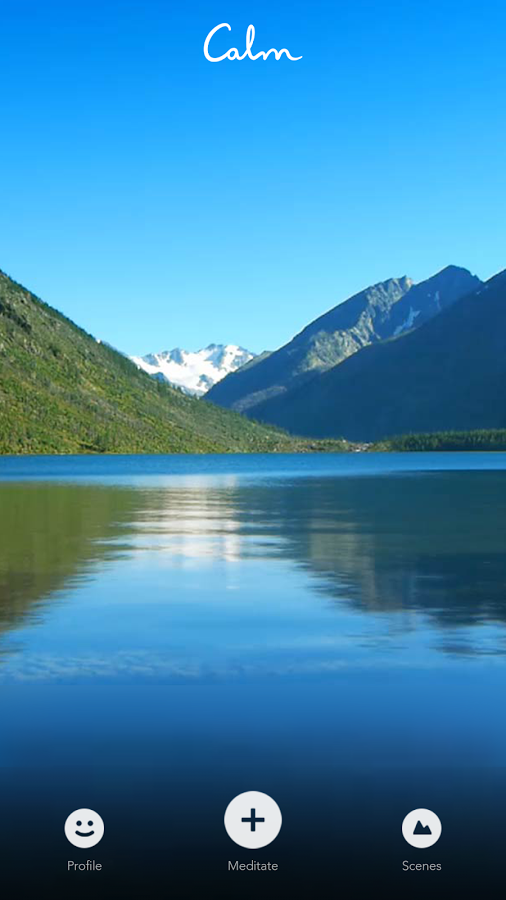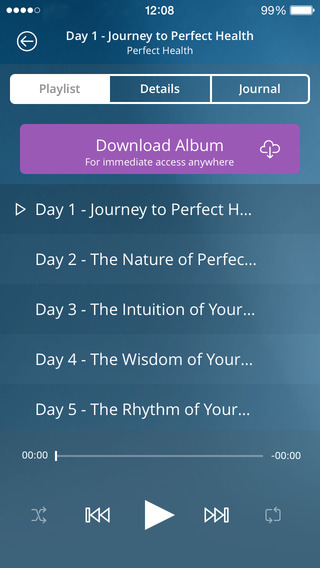Calm (free trial, subscribe for $9.99/month) - My favorite of the minimalist meditation apps right now, Calm takes you through a free 7-day series of 10-minute guided sessions, accompanied by soothing sounds like rain or crashing waves. Your screen is taken over by a relaxing moving wallpaper that you can choose to run in the background (Silent Clouds and Mountain Lake are as nice to look at as they sound).
Headspace (free trial, subscribe for $12.99/month) - Similar to Calm, Headspace’s quirky Web 3.0 animations introduce you to each guided meditation with a focus for the day. There’s more of a motivating flavor here for those who like the challenge. This app’s notifications make a game out of building the mediation habit, which may just lead you to a more consistent practice.
Deepak and Oprah’s 21-Day Meditation Experience - Oprah and Deepak are the OGs in this space. Sign up on the Chopra Center’s website, and you’ll be notified when a free 21-day experience is available (otherwise these packages fall in the $50 range). In each session, Oprah does a very Oprah-like inspirational warm-up to the focus Deepak has for the day. After being given a mantra you’re left to yourself with ambient music, and a soft bell rings to signal the end of the full 20-minute session.
Bonus: Mediation Timer - This is for purists who just want to keep the time. Meditation timer does what it says it does, no extraordinary sights or sounds included besides the functional chimes. Often this is all you need, and for most it's the goal. After going through a few guided sessions, try this simplistic approach to see if it suits you.
And if you’ve already gotten this far, you’ll probably be interested in the 20 practical tips below, courtesy of Leo Babauta and Zen Habits.
Sit for just two minutes. This will seem ridiculously easy, to just meditate for two minutes. That’s perfect. Start with just two minutes a day for a week. If that goes well, increase by another two minutes and do that for a week. If all goes well, by increasing just a little at a time, you’ll be meditating for 10 minutes a day in the 2nd month, which is amazing! But start small first.
Do it first thing each morning. It’s easy to say, “I’ll meditate every day,” but then forget to do it. Instead, set a reminder for every morning when you get up, and put a note that says “meditate” somewhere where you’ll see it.
Don’t get caught up in the how — just do. Most people worry about where to sit, how to sit, what cushion to use … this is all nice, but it’s not that important to get started. Start just by sitting on a chair, or on your couch. Or on your bed. If you’re comfortable on the ground, sit cross-legged. It’s just for two minutes at first anyway, so just sit. Later you can worry about optimizing it so you’ll be comfortable for longer, but in the beginning it doesn’t matter much, just sit somewhere quiet and comfortable.
Check in with how you’re feeling. As you first settle into your meditation session, simply check to see how you’re feeling. How does your body feel? What is the quality of your mind? Busy? Tired? Anxious? See whatever you’re bringing to this meditation session as completely OK.
Count your breaths. Now that you’re settled in, turn your attention to your breath. Just place the attention on your breath as it comes in, and follow it through your nose all the way down to your lungs. Try counting “one” as you take in the first breath, then “two” as you breathe out. Repeat this to the count of 10, then start again at one.
Come back when you wander. Your mind will wander. This is an almost absolute certainty. There’s no problem with that. When you notice your mind wandering, smile, and simply gently return to your breath. Count “one” again, and start over. You might feel a little frustration, but it’s perfectly OK to not stay focused, we all do it. This is the practice, and you won’t be good at it for a little while.
Develop a loving attitude. When you notice thoughts and feelings arising during meditation, as they will, look at them with a friendly attitude. See them as friends, not intruders or enemies. They are a part of you, though not all of you. Be friendly and not harsh.
Don’t worry too much that you’re doing it wrong. You will worry you’re doing it wrong. That’s OK, we all do. You’re not doing it wrong. There’s no perfect way to do it, just be happy you’re doing it.
Don’t worry about clearing the mind. Lots of people think meditation is about clearing your mind, or stopping all thoughts. It’s not. This can sometimes happen, but it’s not the “goal” of meditation. If you have thoughts, that’s normal. We all do. Our brains are thought factories, and we can’t just shut them down. Instead, just try to practice focusing your attention, and practice some more when your mind wanders.
Stay with whatever arises. When thoughts or feelings arise, and they will, you might try staying with them awhile. Yes, I know I said to return to the breath, but after you practice that for a week, you might also try staying with a thought or feeling that arises. We tend to want to avoid feelings like frustration, anger, anxiety … but an amazingly useful meditation practice is to stay with the feeling for awhile. Just stay, and be curious.
Get to know yourself. This practice isn’t just about focusing your attention, it’s about learning how your mind works. What’s going on inside there? It’s murky, but by watching your mind wander, get frustrated, avoid difficult feelings … you can start to understand yourself.
Become friends with yourself. As you get to know yourself, do it with a friendly attitude instead of one of criticism. You’re getting to know a friend. Smile and give yourself love.
Do a body scan. Another thing you can do, once you become a little better at following your breath, is focus your attention on one body part at a time. Start at the soles of your feet — how do those feel? Slowly move to your toes, the tops of your feet, your ankles, all the way to the top of your head.
Notice the light, sounds, energy. Another place to put your attention, again, after you’ve practice with your breath for at least a week, is the light all around you. Just keep your eyes on one spot, and notice the light in the room you’re in. Another day, just focus on noticing sounds. Another day, try to notice the energy in the room all around you (including light and sounds).
Really commit yourself. Don’t just say, “Sure, I’ll try this for a couple days.” Really commit yourself to this. In your mind, be locked in, for at least a month.
You can do it anywhere. If you’re traveling or something comes up in the morning, you can do meditation in your office. In the park. During your commute. As you walk somewhere. Sitting meditation is the best place to start, but in truth, you’re practicing for this kind of mindfulness in your entire life.
Follow guided meditation. If it helps, you can try following guided meditations to start with. My wife is using Tara Brach’s guided meditations, and she finds them very helpful.
Check in with friends. While I like meditating alone, you can do it with your spouse or child or a friend. Or just make a commitment with a friend to check in every morning after meditation. It might help you stick with it for longer.
Find a community. Even better, find a community of people who are meditating and join them. This might be a Zen or Tibetan community near you (for example), where you go and meditate with them. Or find an online group and check in with them and ask questions, get support, encourage others. My Sea Change Program has a community like that.
Smile when you’re done. When you’re finished with your two minutes, smile. Be grateful that you had this time to yourself, that you stuck with your commitment, that you showed yourself that you’re trustworthy, where you took the time to get to know yourself and make friends with yourself. That’s an amazing two minutes of your life.













